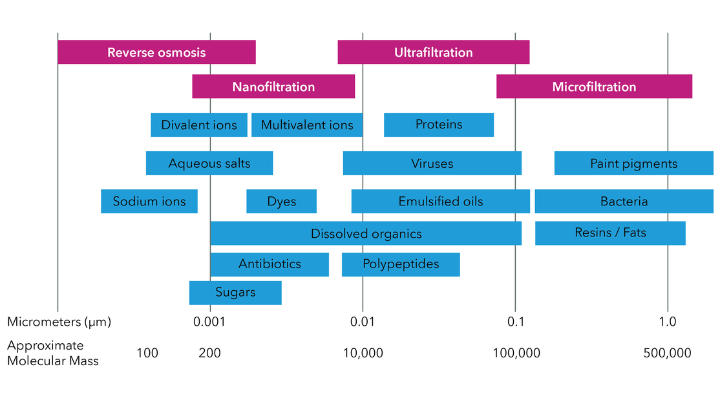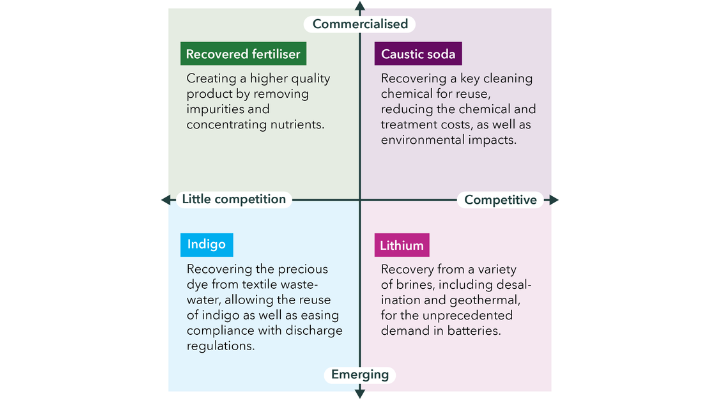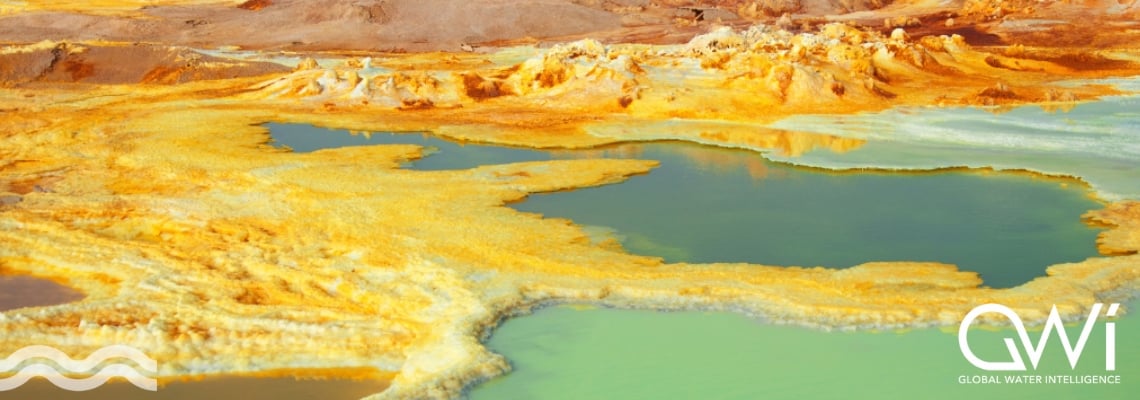Four resource recovery opportunities for nanofiltration
What is nanofiltration?
Nanofiltration (NF) is a type of semi-permeable membrane (a thin selective barrier) used to filter liquids in a multitude of industries. Nanofiltration sits between reverse osmosis and ultrafiltration, as the second tightest membrane with a pore size between 1-10 nanometres. Nanofiltration membranes can be offered in various configurations: the most common is spiral-wound, but hollow-fibre has been gaining traction in the market since its introduction by Pentair X-Flow in 2013. The market is dominated by polymeric NF, but other material options include ceramic and cellulose.Pressure is required to push the liquid through the membrane: the permeate passes through and the concentrate is rejected. Particles can be rejected not only by size-exclusion but also by the membrane’s surface chemistry, which may selectively attract or repel certain contaminants based on their charge or chemical affinity.
Nanofiltration can treat water to a high quality, with a lower energy penalty than reverse osmosis (RO). For applications not requiring the removal of high levels of dissolved salts, nanofiltration membranes can be a useful alternative to RO, with the ability to remove bacteria, viruses, organic matter and divalent ions.
How is nanofiltration used in the water sector?
Nanofiltration was initially used for sulphate removal in the oil and gas sector, but it is now used for a variety of applications, such as water softening, drinking water and treating a multitude of industrial wastewaters and brines. More recently, NF has also been used to remove emerging contaminants from drinking water.
Nanofiltration fits the circular economy ethos by first and foremost recovering high-quality water suitable for reuse, but the recovery of other commodities such as bioresources, minerals and chemicals is gaining traction in the market. Here, four emerging resources that can be recovered using nanofiltration will be explored: lithium, indigo dye, caustic acid and recovered fertiliser.
 Source: Synder
Source: Synder
Caustic soda
Caustic soda, also known as sodium hydroxide (NaOH), is a highly versatile alkali salt that can corrode and dissolve both organic and inorganic materials. As a result, it is used in various industries for cleaning, degreasing, and stripping processes. Discharging caustic soda in wastewater can harm the environment and human health: it raises pH levels in water bodies causing severe alkalinity. If it interacts with some chemicals, it can also create toxic and persistent by-products, such as chlorinated hydrocarbons. Supply chains are increasingly costly and challenging, especially in Europe because of energy and gas price hikes due to the war in Ukraine.Spent caustic typically can’t be reused in plant operations due to the high concentration of contaminants present. Instead, additional chemicals, such as hydrochloric or sulphuric acid, are added to neutralise the stream for discharge. However, using nanofiltration, the spent caustic can be recovered and reused by removing the impurities. This has multiple benefits for the end-user; it eases compliance with discharge standards, minimises chemical and treatment costs, as well as improving the plant’s carbon footprint by reducing reliance on the transport of new chemicals. One of the largest regional consumers of caustic soda is South Asia, which has a widespread textile industry. Here, caustic solutions are valuable not only for cleaning but also as a key part of textile manufacturing, especially the mercerisation process, which improves the strength, lustre, and dye affinity of cotton fibres.
NX Filtration has applied its dNF40 membrane elements to recover caustic from a common effluent treatment plant (CEPT) with a high input of textile wastewater in Jetput, India. The dNF membranes have strong stability at extreme pH levels making them suited to the application. Another commercial example is Koch Separation Solutions (KSS), which offers its Causti-COR nanofiltration membrane system for the textile and food and beverage industries. This system uses spiral-wound nanofiltration membranes which KSS claims can recover up to 95% of caustic for reuse, with a typical pay-back period of less than 18 months. In 2020, KSS also entered a partnership with Waste 3R Engineering + Solutions (W3RES) in Bangladesh, including a focus on the recovery of indigo dye and caustic in the textile industry.
Lithium
Lithium is a critical metal that is rapidly gaining market value as demand increases with the acceleration of decarbonisation efforts, especially for electric vehicles and renewable energy storage. Traditional lithium extraction is an extremely dirty process, with a fragmented supply chain.
It is predominantly mined in Bolivia, Argentina, and Chile (the "lithium triangle") from lithium carbonate-rich brines and transported to China, the monopoly holder for processing and exports. As the industry looks for greener lithium sources, recovery from less conventional sources, such as geothermal, oil and gas, mining, and desalination brines, is becoming more attractive.
While not exclusively applied to less conventional streams, direct lithium extraction (DLE) is generating steady interest for this purpose. Compared to other technologies, DLE offers significant environmental benefits, such as reduced water consumption and a lower carbon footprint, while accelerating the speed of recovery and concentration in comparison to traditional evaporation ponds.
These benefits are driving market interest, with the Chilean government recently stating its support of DLE over other technologies. Unlike conventional lithium extraction methods, DLE does not use solar evaporation ponds to concentrate the brine, which can take up to 18 months. Instead, lithium is extracted directly with technologies such as membranes and ion exchange.
Various NF vendors in the water industry, such as established players DuPont and Koch Separation Solutions, alongside British start-up Evove, are entering the lithium space by utilising their membrane portfolios for DLE processes. The key feature of Evove’s DLE solution is its highly selective lithium membrane, with projects in California and Canada in the planning phase, and future markets in Latin American and Australia. Evove’s 3D printed, ceramic Separonics membrane will be piloted and commercialised in 2024 and 2025 respectively, but upcoming projects will be using nanofiltration membranes with its Enhance graphene oxide coating tailored with high lithium selectivity. Interest is also developing in Europe, where DuPont has partnered with Vulcan Energy to test and scale up a DLE process for geothermal brines in the Upper Rhine Valley, Germany.
 Source: GWI
Source: GWI
Recovered fertiliser
The key nutrients in fertiliser, nitrogen and phosphorus, are becoming scarce, raising concerns about long-term food security. Phosphorus is a finite resource sourced from mining phosphorite, and with global reserves dwindling and limited to a few key regions, supply chains are vulnerable.
Simultaneously, an excess concentration of these precious nutrients is causing serious damage to ecosystems, creating dead zones in water bodies through the process of eutrophication. By capturing and recovering these nutrients to create bioresources, two challenges can be addressed at the same time: food security and environmental degradation.
Although nanofiltration is not essential for recovering fertiliser, it can create a higher quality product by removing impurities and concentrating nutrients in the digestate. While residual chemicals from coagulation-flocculation methods can contaminate the resource, nanofiltration avoids this issue by using a physical membrane for separation rather than chemicals. In addition to creating a high quality bioresource which can create revenue for the end-user, discharge water quality is improved and biosolids disposal costs are reduced.
US start-up ZwitterCo is the market leader for this application. Marketed as superfiltration, its membranes sit on the looser side of NF, between nanofiltration and ultrafiltration. They are extremely hydrophobic as they are made from zwitterions, making them well suited to removing large organics, such as proteins, fats, and grease. ZwitterCo has various references in North America including a recent installation of its superfiltration membranes at what will be the largest digestate-nutrient recovery plant in North America, in partnership with Digested Organics.
Indigo dye
Indigo, the renowned dye responsible for the classic pair of jeans, is a staple in the global textile industry. Textile manufacturing requires notoriously high volumes of water and a significant amount of indigo dye is lost to wastewater. Regardless of whether the dye is synthetic or natural, this loss is a considerably wasteful for textile manufacturers due to its high purchase cost. Additionally, concentrations of dye in wastewater can be toxic even at low levels, polluting and discolouring scarce freshwater resources which consequently inhibits the photosynthetic process by obstructing sunlight penetration into the water body.
Regulations on textile industry wastewater are becoming more stringent, with the growing trend of zero or minimal liquid discharge promoted in India, Bangladesh and China. Nanofiltration can be employed not only to treat the water so it can be reused, but to recover the dyes carried in the wastewater. Therefore, this reduces dye, discharge, and treatment costs as well as water consumption for the end-user, which is especially important as most textile hubs are in water scarce regions.
Dye removal is a standard ability of most nanofiltration membranes on the market, but dye recovery for reuse is offered by a more limited selection of market players, including NX Filtration. While Koch Separation Solutions also offers an indigo recovery system, nanofiltration is used only for dye removal while ultrafiltration is used for recovery.
This article has been produced by our content partner, GWI.
Share your water technology stories with us
Do you have an innovation, research results or an other interesting topic you would like to share with the international water technology industry? The Aquatech website and social media channels are a great platform to showcase your stories!
Please contact our Sr Brand Marketing Manager Annelie Koomen.
Are you an Aquatech exhibitor?
Make sure you add your latest press releases to your Company Profile in the Exhibitor Portal for free exposure.
We promise never to send you spam and you can unsubscribe at any time!
